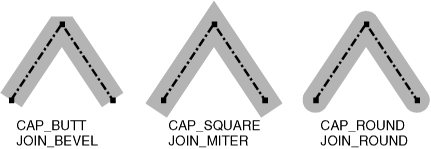12.5 Line Styles with BasicStroke
| In the last couple of examples, we've used the BasicStroke class to draw lines that are wider than the one-pixel lines supported by the Graphics class. Wide lines are more complicated than thin lines, however, so BasicStroke allows you to specify other line attributes as well: the cap style of a line specifies how the endpoints of lines look, and the join style specifies how the corners, or vertices, of shapes look. These style options for endpoints and vertices are shown in Figure 12-6. The figure also illustrates the use of a dot-dashed patterned line, which is another feature of BasicStroke. The figure was produced using the code listed in Example 12-8, which demonstrates how to use BasicStroke to draw wide lines with a variety of cap and join styles and to draw patterned lines. (The example does not illustrate the use of the "miter limit" line style, which comes into play when two lines with a join style of JOIN_MITER intersect at a small angle; in this case the miter can become very long, and must be limited to some maximum length. See BasicStroke documentation for details.) Figure 12-6. Line styles with BasicStroke Example 12-8. LineStyles.javapackage je3.graphics; import java.awt.*; import java.awt.geom.*; /** A demonstration of Java2D line styles */ public class LineStyles implements GraphicsExample { public String getName( ) { return "LineStyles"; } // From GraphicsExample public int getWidth( ) { return 450; } // From GraphicsExample public int getHeight( ) { return 180; } // From GraphicsExample int[ ] xpoints = new int[ ] { 0, 50, 100 }; // X coordinates of our shape int[ ] ypoints = new int[ ] { 75, 0, 75 }; // Y coordinates of our shape // Here are three different line styles we will demonstrate // They are thick lines with different cap and join styles Stroke[ ] linestyles = new Stroke[ ] { new BasicStroke(25.0f, BasicStroke.CAP_BUTT, BasicStroke.JOIN_BEVEL), new BasicStroke(25.0f, BasicStroke.CAP_SQUARE, BasicStroke.JOIN_MITER), new BasicStroke(25.0f, BasicStroke.CAP_ROUND, BasicStroke.JOIN_ROUND), }; // Another line style: a 2 pixel-wide dot-dashed line Stroke thindashed = new BasicStroke(2.0f, // line width /* cap style */ BasicStroke.CAP_BUTT, /* join style, miter limit */ BasicStroke.JOIN_BEVEL, 1.0f, /* the dash pattern */ new float[ ] {8.0f, 3.0f, 2.0f, 3.0f}, /* the dash phase */ 0.0f); /* on 8, off 3, on 2, off 3 */ // Labels to appear in the diagram, and the font to use to display them. Font font = new Font("Helvetica", Font.BOLD, 12); String[ ] capNames = new String[ ] {"CAP_BUTT", "CAP_SQUARE","CAP_ROUND"}; String[ ] joinNames = new String[ ] {"JOIN_BEVEL","JOIN_MITER","JOIN_ROUND"}; /** This method draws the example figure */ public void draw(Graphics2D g, Component c) { // Use anti-aliasing to avoid "jaggies" in the lines g.setRenderingHint(RenderingHints.KEY_ANTIALIASING, RenderingHints.VALUE_ANTIALIAS_ON); // Define the shape to draw GeneralPath shape = new GeneralPath( ); shape.moveTo(xpoints[0], ypoints[0]); // start at point 0 shape.lineTo(xpoints[1], ypoints[1]); // draw a line to point 1 shape.lineTo(xpoints[2], ypoints[2]); // and then on to point 2 // Move the origin to the right and down, creating a margin g.translate(20,40); // Now loop, drawing our shape with the three different line styles for(int i = 0; i < linestyles.length; i++) { g.setColor(Color.gray); // Draw a gray line g.setStroke(linestyles[i]); // Select the line style to use g.draw(shape); // Draw the shape g.setColor(Color.black); // Now use black g.setStroke(thindashed); // And the thin dashed line g.draw(shape); // And draw the shape again. // Highlight the location of the vertexes of the shape // This accentuates the cap and join styles we're demonstrating for(int j = 0; j < xpoints.length; j++) g.fillRect(xpoints[j]-2, ypoints[j]-2, 5, 5); g.drawString(capNames[i], 5, 105); // Label the cap style g.drawString(joinNames[i], 5, 120); // Label the join style g.translate(150, 0); // Move over to the right before looping again } } } |
EAN: 2147483647
Pages: 285